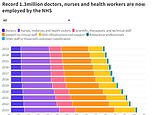The NHS workforce is larger than ever, official figures revealed today.
As of September 2023, more than 1.3 million doctors, nurses and administrative staff were working full-time in the health service in England.
This is an increase of more than a third in the space of a decade.
The figures come amid repeated warnings of a jobs crisis which experts say is jeopardizing efforts to tackle backlogs in the NHS.
Analysis by the Office for National Statistics (ONS) found that staff numbers have increased across all groups over the past decade.
Your browser does not support iframes.
Your browser does not support iframes.
Doctors experienced the biggest increase (37 per cent), with 138,000 now working in the health service, up from just over 100,000 in 2013.
The number of nurses, midwives and health visitors also increased by more than a fifth (363,000).
Clinical support staff, including physical therapy assistants and prosthetic technicians, make up the largest proportion of the workforce, with 405,000 employees.
The NHS receives around £160bn a year, of which a large portion is spent on paying staff.
Yet despite the rising bill and growing workforce, right-wing think tanks say results have gotten worse. As such, the NHS has been described as a “black hole of taxpayers’ money”.
The last time the NHS nationally met its A&E time target – for 95 per cent of patients to be admitted, transferred or discharged within four hours of arrival – was in 2015.
Meanwhile, a National Audit Office report last year found it had fallen short of its target of completing all hospital ambulance handovers within 30 minutes since it began collecting data in November 2017.
Queues for routine treatment soared to an all-time high in the wake of the pandemic – with 7.6 million people currently stuck in queues in England alone.
For comparison, the waiting list in England was 4.6 million in December 2019.
The latest statistics also reveal that England’s population has grown by 3.4 million (6.5 per cent) in a decade, further stretching NHS services.
Likewise, England’s population is aging.
The Health Foundation estimates that the number of people over the age of 85 will double to 2.6 million in the next 25 years.
The proportion of people aged over 75 with a chronic illness has also increased, and needs are likely to become more complex, driving demand for NHS services.
According to ONS figures today, the number of doctors registered in the UK with the General Medical Council reached 296,000 in December 2022, the latest data available.
This is an increase of almost a fifth (18.4 percent) reported in December 2018 (250,000).
The latest data from the Nursing and Midwifery Council (NMC) also shows that there were almost 798,000 nurses, midwives and dual registrants on the register as of 30 September 2023 in the UK.
It had increased 15 percent compared to the 693,000 registered in September 2018.
Your browser does not support iframes.
Your browser does not support iframes.
But officials have long warned that the NHS’s over-reliance on foreign nurses and midwives is “not sustainable”.
It comes as estimates published last month by NHS Digital show that foreign nationals make up a fifth of all NHS staff in England.
Three in 10 nurses and more than a third of doctors are non-UK residents – the first time this milestone has been reached.
Some 215 nationalities are now represented in the NHS workforce.
Latest figures suggest the number of UK-trained nurses registered to work in Britain has increased by 22,000 since 2019.
However, this is half the increase seen in overseas-trained personnel over the same period, which is approaching 44,000. This means international recruits account for two-thirds of the growth.
Some also come from “red list” countries, where the World Health Organization considers the nursing shortage serious and urges rich countries not to poach staff.


